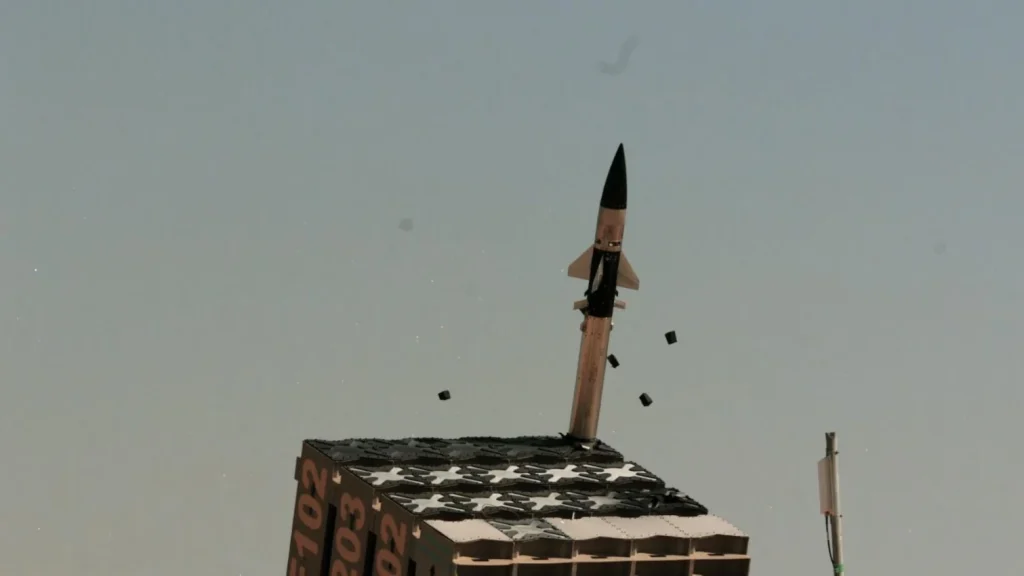Israeli company RAFAEL announced that its Iron Dome ground launcher and Tamir interceptor missile integrated into the US Marine Corps (USMC) Medium-Range Intercept Capability (MRIC) Prototype had passed the test.
On June 30, 2022, the Marine Corps’ MRIC prototype successfully struck several concurrently launched cruise missile representative targets at the White Sands Missile Range in New Mexico, says USMC release.
The system fills an emerging capacity gap for the Marine Corps and is one of several crucial efforts for Force Design 2030. The Program Executive Officer Land System’s Ground-Based Air Defense (GBAD) programme manages the system.
Don Kelley, the program manager for GBAD at PEO Land Systems, said the program now has “relevant capability”.
MRIC also uses technology from Israel’s successful Iron Dome system, and it is integrated with the Corps’ Ground/Air Task-Oriented Radar, or G/ATOR Radar, and Common Aviation Command and Control System, known as CAC2S Battle Management System, the key components. The purpose of the live-fire test was to verify the critical subsystems’ integrations and the system’s overall capacity to deliver crucial information to senior Marine Corps leadership as they make decisions on the MRIC prototype’s future course.
The Israeli Iron Dome components were effectively monitored by the G/ATOR during the test, starting just after launch and continuing through the CAC2S. This made it possible for the MRIC system to simultaneously destroy many missiles that were around it from different directions. At its height, the MRIC prototype was surrounded by multiple in-air targets, each with a distinct flight trajectory and velocity. MRIC fired the Tamir missile and struck each target with success.
The first Test
The test conducted last month expanded on the last live-fire test conducted in December, in which the programme office fired a number of targets sequentially, and MRIC successfully intercepted each target before another launch followed it.
The current test
This time, in June, several targets were launched at once. According to Kelley, engineers at the Naval Surface Warfare Center Dahlgren independently simulated what would occur during the live-fire test before the test. According to Kelley, the outcomes showed strong agreement with the predicted scenarios.

The next and last test
According to Kelley, the system will undergo one more live-fire test from the programme office at a higher danger level later this year. Marine Corps leadership will decide the program’s future, including which Marines will eventually employ the system and the necessary training required to operate the brand-new capability after the last live-fire exercise.
The tests’ objective was to get this prototype into a deployable state that satisfies USMC’s current requirements while allowing other systems to be “plugged in” to it to increase its lethality while preserving expeditionary capability, mobility, and the ability to quickly set up and be operational at any location, at any time, said Maj James Slocum, who since the program’s launch in 2018, has bee the MRIC Medium Range Intercept Capability team lead at PEO Land Systems.
To quickly build and demonstrate a relevant capability, Slocum said the program’s goal was to combine tested components into a system compliant with the Marine Corps architecture utilising the Middle Tier of Acquisition powers.
Slocum said that since the long-range cruise missiles and air defense systems get better and better, air superiority is no longer a given; USMC needs to be able to counter these types of opportunities.
The successful experiment, according to Moshe Fattal, head of the Mapa Ministry’s Ministry of Defense, demonstrated that the Tamir Iron Dome interceptor, along with its ground alignment, is capable of integrating quickly and effectively into any pertinent air defence system and intercepting a variety of air threats in complicated scenarios.
After the event, Brig. Gen. Mark Clingan, deputy commanding general of the Marine Corps Combat Development Command and assistant deputy commandant for combat development and integration, said that the system’s potential is demonstrated by the fact that USMC is talking about the training pipeline rather than the system as a whole.
RAFAEL Air and Missile Defense Executive Vice President and General Manager Pinchas Jungman noted that as part of operational training, US troops used a system that functioned optimally against multiple threats and intercepted targets from different distances.
Joe Biden inspects Israeli Air Defense systems
On July 13, Joe Biden, during his trip to Israel, had the firsthand opportunity to see Israeli most advanced air defense systems including the ‘Iron Dome’ anti-missile interception system (which, according to the manufacturers, boasts a success rate of 90%), the ‘Arrow’, the ‘David’s Sling’ and the brand new Magen Or (Shield of light), a laser interception system that has passed the experimental phase and which, according to local analysts, should become operational in two to three years.
Tamir interceptor missile and Iron Dome
The Tamir missile from Iron Dome system eliminates approaching dangers originating from distances of 4 to 70 km. The Tamir missiles include steering fins with proximity fuze burst warheads and electro-optical sensors. Iron Dome is the launcher for the missile.
The U.S. Army declared its intention to purchase two Iron Dome batteries in 2019 to meet a temporary capabilities requirement. Given the U.S. and numerous other countries’ interest in Iron Dome’s distinctive capabilities, Raytheon Missiles & Defense and Rafael have introduced the SkyHunter system. SkyHunter can be manufactured in the US based on Iron Dome to increase capacity and availability for the US and its allies.
These systems provide lowest layer defence, and Rafael and Raytheon Missiles & Defense are working together to develop the David’s Sling System, which provides higher layer defence.
